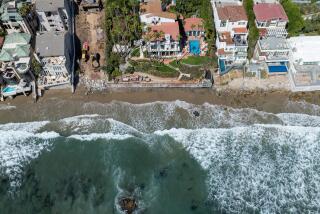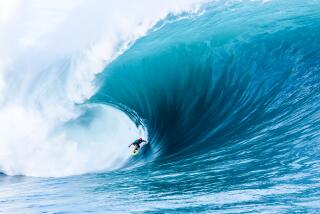ART : THE ART OF SURFING : The Beach in Brea? It’s All Part of the Fun of the Splashy Exhibit ‘Cowabunga’
- Share via
Forget contaminated waters, washed-up garbage and surfers snarling over territory. Instead, think Frankie and Annette snuggling on the sand, Duke Kahanamoku happily carving a long-board and adolescent skateboard lust through the decades.
That’s the California scene grinningly glorified in the Brea Civic and Cultural Center Gallery’s “Cowabunga: The Beach Hits Brea” show. It’s an exhibit devoted to bronzed nostalgia and the notion that the shore is the coolest place to be.
“This is really more for the fun of it,” said organizer Emily Keller, conceding that her show is as shallow as a tide pool--but just as interesting.
“We didn’t feel like we could go into the sociological aspects of the culture, but we have tried to give people a visual impact of what has become symbolic of Southern California. . . . We wanted to [give an idea] of the thrill of living here.”
Surfboards are the most ubiquitous symbol of that lifestyle, at least in Brea through July 28. Lisa Gee, who put together the exhibit with Keller, gathered more than 50, ranging from huge, hollow wooden ones made at the turn of the century to the small, sleek models used today.
Gee also rounded up a large collection of skateboards. Most are old-fashioned, with clay wheels that had the unfortunate habit of snagging on the tiniest pebble, catapulting riders onto the sidewalk. In dude-speak, that’s called a “face plant.” (These days, skateboard wheels are made of hard rubber.)
Other displays include men’s and women’s beachwear from 1910 on, old surfing magazines and posters, belly and body boards and the sheared-off front of a Volkswagen bus (a mainstay of ‘70s surfing expeditions). There’s also a grouping of modern kites, some in abstract shapes, others more naturalistic--like the 10-foot-long one in the shape of a shark.
A centerpiece is the sandy re-creation of a shore scene that looks as though it was pulled straight from the set of a ‘60s beach movie. The de rigueur surfboard is there, as are the towels, straw hat, bongos, seaside umbrella, cooler and skateboard.
The tableau inspired a flashback in Samuel Waller, a high school wood-shop teacher from Fullerton who visited the show recently.
“The only thing I don’t see is the beer,” laughed Waller, 47, who said that, as a teen-ager in the late ‘60s, he hitchhiked to Newport Beach almost daily from his parents’ Fountain Valley home.
“I was more a body-surfer than a surfer, so the Wedge [a Balboa Peninsula spot known for its large, dangerous waves] was where we headed. . . . Actually, I was more into finding the party, [which this exhibit] really reminds me of. The cooler had beer, though, or wine.”
His 7-year-old son, Tyler, was more bemused by the scene than anything else. Why, his face seemed to ask, would anybody take the time to stick an umbrella in a patch of sand inside a building? The sandcastle exhibit around the corner made more sense.
Although only nodding that he liked it, Tyler stood transfixed in front of the three sandcastles that were made outside the gallery and brought in for display. Tyler also appreciated the sandbox nearby, which allowed him and other kids to make their own castles.
The sandbox underscores the exhibit’s hands-on quality, noted Keller. She also pointed to a rough, incomplete surfboard, which visitors are invited to help shape with tools provided. Children and adults will be supervised, usually by someone experienced at board-making.
“We want all this to emphasize the tactile because so much of our culture here involves sensations,” Keller explained, adding that several of the surfboards can be handled.
Many are unusual, some unique. There’s Kahanamoku’s “Victory Wing” board, which he carved in 1928, and a motorized metal board that Gee said was designed by a man who enjoyed surfing but wasn’t strong enough to paddle out. A pair of experimental “maximum speed” boards, each with a series of holes used to cut friction by channeling rushing water, are also featured.
Modern, whippet-like boards most impressed Karen Salino, a Brea resident who grew up watching her brother surf on the bulkier boards common in the ‘60s.
“That thing was very heavy, and he had a hard time dragging it around,” recalled Salino, 44. “I bet he would have had more fun with one of [these new boards]. Just look at them; they’re almost sexy.”
* What: “Cowabunga: The Beach Hits Brea.”
* When: Through July 28. Hours: noon to 5 p.m. Wednesday, Saturday and Sunday; noon to 8 p.m. Thursday and Friday.
* Where: Brea Civic & Cultural Center Gallery, 1 Civic Center Circle, Brea.
* Whereabouts: Take the Orange (57) Freeway to Imperial Highway and head west to State College Boulevard, then go north to Birch Street. Go west on Birch to Civic Center Circle.
* Wherewithal: $1; free to anyone under 18.
* Where to call: (714) 990-7713.
MORE ART
IN LOS ANGELES: KANDINSKY
A stunning and rare gathering of Wassily Kandinsky’s “Compositions,” painted between 1910 and 1939, is at the Los Angeles County Museum of Art through Sept. 3. The works reflect the artist’s search for a formal language to convey spiritual meaning. (213) 857-6000.
IN LOS ANGELES: TWOMBLY
A major survey of the refined poetry of idiosyncratic American abstract painter and sculptor Cy Twombly, at the Museum of Contemporary Art through June 25, includes little-known early works as well as rarely seen works from European private collections. (213) 626-6222.
IN RIVERSIDE: FAR AND NEAR
The coolly analytical aesthetic of German photographers Bernd and Hilla Becher and their students is the subject of “Distance and Proximity,” through July 30 at the UCR/California Museum of Photography in Riverside. Also: “Vidkids,” videos by schoolchildren, through July 23. (909) 784-3686.


